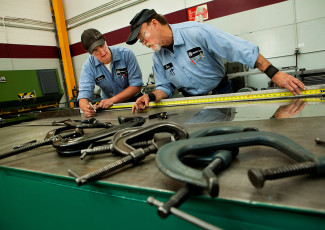Utah Community College Grows Its Apprenticeship Programs
By Dennis Pierce
May 6, 2015
Over the past four years, the college has promoted its plumbing- and electrical-technology programs, drawing students and employers alike.
Salt Lake Community College’s four-year apprenticeship programs in fields such as plumbing- and electrical-technology are growing, with benefits to both students and local employers. While this growth is largely a function of the economic recovery, trades program manager Ralph Tasker’s relentless promotion of these programs also has been key.
Aiming to fill a widening skills gap within Utah’s construction industry, the apprenticeship programs allow students to get on-the-job training with a licensed professional during the day, and in-class education two nights per week. After four years, students can take a test to earn their journeyman license — at which point they’ll be earning between $50,000 and $65,000 per year.
Typically, when the economy goes bad, community colleges see a spike in student enrollment, Tasker says. But an apprenticeship “is a different animal.” Enrollment in these programs generally takes a dive during a recession, because businesses aren’t hiring, or they are forced to lay off workers.
Now that the economy has picked up again, “our apprenticeships have more than doubled in size the past few years,” Tasker says. But his efforts to evangelize the programs have helped as well.
Promoting apprenticeship programs at high schools
“We go to a lot of high school open houses and try to get the message out about our apprenticeship programs,” Tasker says. “Most people don’t have a clue about what an apprenticeship is, so it’s kind of eye-opening.”
Tasker also attends conferences for high school guidance counselors to make sure they are aware of these programs. At one recent event, Tasker used a spreadsheet delineating the salary schedule — from a first-year teacher to someone who has a doctorate — of one of the local school districts.
“Below that, we put the apprenticeship [pay] scale,” he says, “and the most common remark I heard was, ‘Did you give this to us just to make us depressed?’”
An apprentice electrician or plumber starting his or her second year in the program, who has had only two semesters of schooling, is making the same amount as a first-year teacher with a bachelor’s degree, Tasker says. Apprentices start at about 50 percent of a journeyman salary, and they get two 5 percent raises per year. When they receive their journeyman license, they earn the full salary.
“It would take a teacher with a master’s degree 16 years to make the same wages as an electrician after four years,” he says.
Earnings potential is one big incentive for apprentices, but another is that they get half off the cost of their tuition. “Currently, for five credit hours — one semester of schooling — the cost is $353,” Tasker says. “That’s pretty darn reasonable.”
What’s more, many employers pay for part or all of an apprentice’s schooling, provided they earn good grades. “They don’t have to, but many do, in order to stay competitive,” Tasker says. Some even go so far as to pay for apprentices’ books, which can cost up to $400 a year.
Reaching out to the community
Interest in the college’s apprenticeship programs is employer-driven as well, and Tasker serves on several local workforce boards to promote these offerings.
“Employers often will call us and say, ‘We’ve got some people we’d like to get trained,’ and then we contact additional employers to see if we can find enough interest to open up an apprenticeship in that field again,” he explains.
With the licensed trades, it’s an easy sell, because the training is required for these fields. For nonlicensed trades, such as HVAC installation, it’s more difficult. Still, Salt Lake Community College has just opened new apprenticeship programs for brickmasons and stagehands as well.
Growing the apprenticeship programs is good business for the college — but it also serves an important workforce need.
“The feedback I get from employers is that they can’t find enough people to hire,” Tasker says. “If they could find enough people who were good candidates, they’d hire 10 right now if they could. But they can’t find people who want to work.”
Does your college have a successful apprenticeship program? Tell us about it in the Comments.










